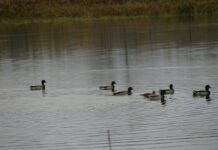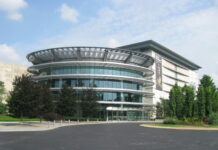Photo credit: DiasporaEngager (www.DiasporaEngager.com).
Investigation and Results
Epidemiologic Investigation
Napa County Public Health (NCPH) defined a confirmed case as the diagnosis of Legionnaires disease based on the results of a urinary antigen test (UAT), polymerase chain reaction (PCR) test, or culture received by a person who lived, worked, or spent time in downtown Napa, with illness onset during or after June 2022. A suspected case was defined as community-acquired pneumonia of unknown origin identified among three categories of persons: 1) a hospitalized patient; 2) a resident of, worker in, or visitor to downtown Napa; or 3) a patient who did not receive testing for Legionella spp. during hospitalization.
During July 11–August 15, 2022, NCPH identified 17 Legionnaires disease cases, including 14 confirmed and three suspected cases (Table 1). Among these 17 cases, 16 persons were hospitalized, 10 were admitted to an intensive care unit, and five required intubation and mechanical ventilation; one patient died. Comorbidities included smoking, diabetes, hypertension, lung disease, and heart disease. Two patients were coinfected with SARS-CoV-2, the virus that causes COVID-19. The longest hospital stay was 36 days. All confirmed cases were diagnosed by UAT results. Lower respiratory tract specimens were collected from four patients with confirmed Legionnaires disease; L. pneumophila serogroup 1 was detected by PCR in two clinical specimens, one of which yielded an isolate, which is necessary for whole genome sequencing. Interviews with patients or their proxies revealed that 14 patients lived in downtown Napa, two visited downtown Napa, and one worked in downtown Napa.
Environmental Health Investigation
The search for potential environmental sources began with the delimitation of a high-risk zone, which was defined as the area within a 1.0-mile (1.6-km) radius from the center of a circle drawn around the cluster of patients’ residences plotted on a point density heat map generated using ArcGIS Pro (version 3.0; Esri) (Figure). Aerial imagery, onsite visual inspections, and calls to businesses and cooling tower maintenance companies identified and confirmed the locations and uses of cooling towers.* Environmental sampling locations were selected on the basis of patient interviews, and a risk score analysis was derived from the geographic proximity of facilities with cooling towers and other aerosolizing devices to the patients’ residences. A total of seven facilities with nine potential exposure sources (seven cooling towers, one decorative fountain, and one produce mister) were mapped within the high-risk zone (Figure) (Table 2). Cooling towers located at facilities A and B were the highest scoring devices in the risk score analysis.
Visual inspection, review of records, and sampling of devices within the high-risk zone revealed a lack of maintenance at most cooling towers. Many had low or no detectable chlorine at the time of sampling, because of lack of routine biocide application, improper distribution methods, or other problems with the system.† Facility A’s cooling tower had a clog in the pipe leading to the chemical feed system that impeded the controller’s ability to detect water flow, resulting in low or no injection of biocide into the tower. According to maintenance records, the clog was detected in early July, at approximately the same time that many case exposures occurred and was resolved in early August.
Public health investigators collected environmental samples from 11 potential sources. Seven samples tested positive for Legionella (six for L. pneumophila only and one for both L. pneumophila and Legionella anisa); all positive samples were collected within the high-risk zone.
Laboratory Investigation
L. pneumophila culture–positive clinical and environmental specimens underwent sequence-based typing at CDC and whole genome sequencing followed by single-nucleotide polymorphism (SNP) analysis at the California Department of Public Health (CDPH). Sequence-based typing generates an allelic profile based on the combination of allele numbers at seven loci (1). Each unique allelic profile corresponds to a sequence type (ST). Nested sequence-based typing, a culture-independent variation of sequence-based typing, was performed on the PCR-positive clinical specimen from which no isolate was recovered. In SNP analysis, whole genome sequencing data generated from isolates are aligned to a reference genome, and the variation from the reference is used to infer relatedness among isolates, visualized in a phylogenetic tree. A smaller number of SNP differences indicates closer relatedness (2).
The identified L. pneumophila STs from environmental samples included ST1, ST10, ST35, and ST296 (Table 2). ST35 was detected in the clinical isolate via sequence-based typing. Nested sequence-based typing performed on the PCR-positive, culture-negative clinical specimen also detected ST35. The only environmental sample that yielded ST35 was collected from the facility A cooling tower. No SNP differences between the clinical isolate and the facility A cooling tower isolate were identified, indicating that they were highly related, whereas other environmental isolates were genetically distant from facility A’s cooling tower isolate (Supplementary Figure, https://stacks.cdc.gov/view/cdc/136165). This activity was reviewed by CDC, deemed not research, and was conducted consistent with applicable federal law and CDC policy.§
Source of original article: Centers for Disease Control and Prevention (CDC) / Morbidity and Mortality Weekly Report (MMWR) (tools.cdc.gov).
The content of this article does not necessarily reflect the views or opinion of Global Diaspora News (www.GlobalDiasporaNews.com).
To submit your press release: (https://www.GlobalDiasporaNews.com/pr).
To advertise on Global Diaspora News: (www.GlobalDiasporaNews.com/ads).
Sign up to Global Diaspora News newsletter (https://www.GlobalDiasporaNews.com/newsletter/) to start receiving updates and opportunities directly in your email inbox for free.

































